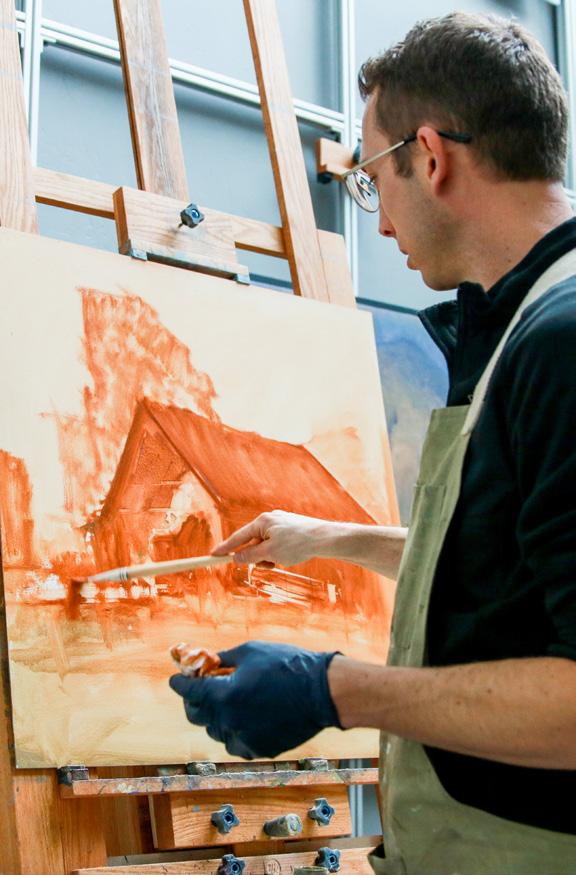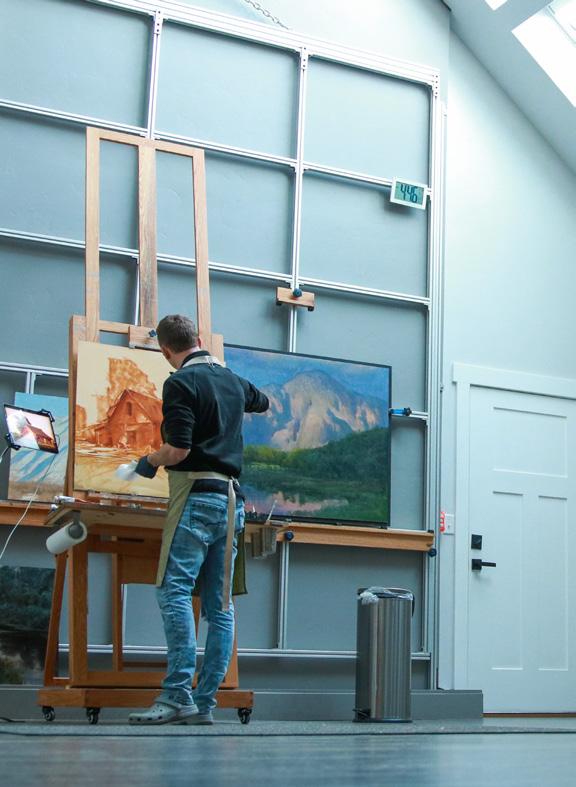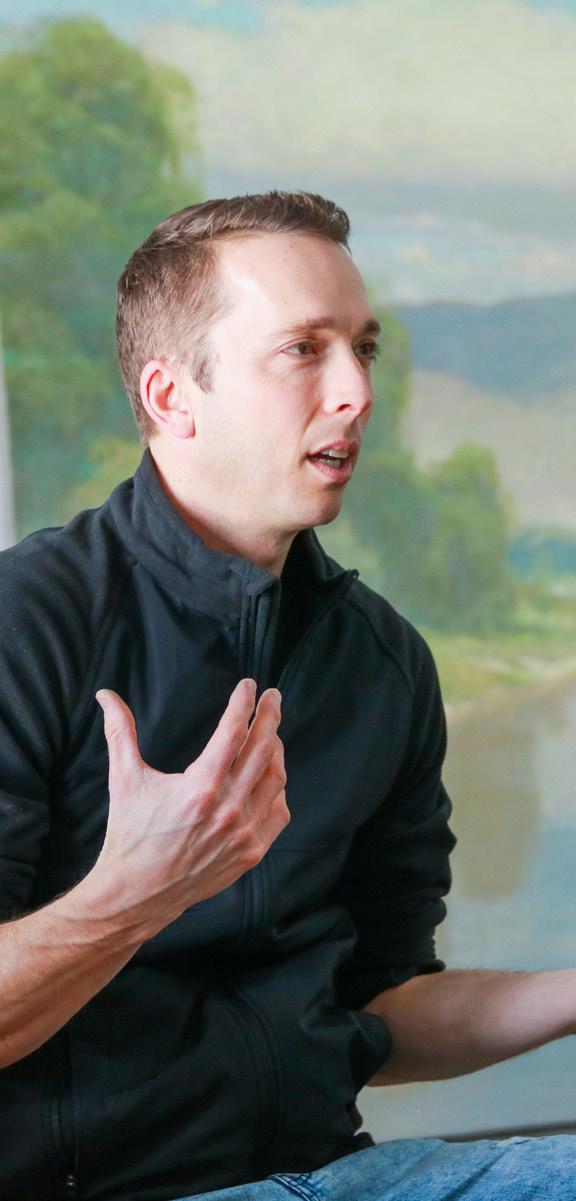
5 minute read
Nature artists of Cache Valley: Capturing wild expression
Harrison Larson Photos By Claire Ott
Cache Valley is home to many great artists who strive to capture the beauty surrounding them every day. From wildlife and sport painting to capturing the majesty of a landscape, the artists in the valley paint inspired glimpses of nature.
Joshua Clare and Luke Frazier are painters inspired by the natural world. While different in what they depict in their works, both have a deep appreciation for nature and create works inspired by that passion.
Joshua Clare, a painter based in Paradise, Utah, creates works inspired by the natural landscapes around him. Known for his still-life paintings, he strives to depict the world around him in meaningful ways.
Clare grew up in Salem, Utah, and spent much of his childhood reading, drawing and playing outside on his family’s farm.
“I read, I drew, I played outside a lot and I worked a lot with my dad outside. We had a kind of ‘play’ farm — he always wanted that — so I did a lot on the farm,” Clare said. “I rode horses and did all of the projects that go along with that.”
Clare said much of his inspiration for pursuing art came from the books and movies he watched as a child.
“So when I was little, it was ‘Calvin and Hobbs’ and the classic Disneys. I was in the era — I’m forty, which is amazing — but I was in the era of ‘Aladdin,’ ‘Beauty and the Beast,’ and ‘The Little Mermaid’ and those signature Glen Keane drawings, and I want to be able to draw like that,” Clare said. “That is part of what sparked my love of drawing.”
Clare said that initially, he wanted to be an animator, but with the rise of CGI, he wanted to stay with physical mediums, which led him to painting.
“I knew that digital was the future for the movie industry — I knew that drawing was phasing out — and so I knew that wasn’t an option anymore, and I didn’t want to be on the computer to create traditional work and so I started exploring in the painting world,” Clare said.
Clare said nature inspires his art because it is the most beautiful thing people can experience.
“The epitome of beauty to me is nature, it’s the most beautiful thing that we know. I feel like there is more beauty in store for us, but that’s otherworldly — that’s to come — so the finest beauty that we can encounter as humans is God’s creation,” Clare said. “Why is nature so inspiring? Because it’s perfect. It’s so hard for me to imagine anything more beautiful than it — impossible, actually.”
Clare said nature is so beautiful because it is unified while still being full of uniqueness.
“Nature is a perfection of unity with unlimited variety, and I think that’s the best definition of beauty that I have come across, is unity in variety,” Clare said.
“The longer I live, the more that I think that’s true, just with people as well — with friendships or communities — it’s more beautiful when you get a variety of ages and occupations, and every way that you can make a human different: race and ethnicity, and gender and social status, and education. You can get a huge group of people to get together and have them unified in spite of all that variety. It’s unbelievably beautiful, and that’s what nature is. It’s this perfect harmony with unlimited variety.”
Clare said moving forward, he wants to create paintings that don’t just depict nature, but express the feeling of nature.
“I crave — I want desperately — to paint stuff the way it feels and not just the way it looks. To move from essays on nature to poems on nature,” Clare said. “The difference between a song that tells you everything and that you can’t engage in, and a fine piece of classical music that takes you wherever you want to go.”
Clare is a passionate artist who continues to develop and express his style with his paintings, creating beautiful landscapes built on nature’s harmony as well as portraits using the same principles. You can find more of his work and contact him at joshclare.com.
Luke Frazier, a graduate of Utah State University with a bachelor’s degree in painting and a master’s degree in illustration, creates works inspired by wildlife and outdoor sporting.
His paintings depict animals everywhere from Alaska to Africa. Based in Cache Valley, he has been creating works for over three decades.
In a virtual interview, Frazier said while growing up in the Salt Lake area, he enjoyed spending time outdoors and hunting and fishing with his brothers, activities which have had an influence on the work he paints now.
“I was always outdoors — always in the hills, always fishing every creek we could find, trapping with my brothers, doing snow sports, but it mainly had to do with hunting and fishing. Always, all the time,” Frazier said. “It was a pastime we enjoyed, and provided for our large family that way as well. And that’s probably why I paint wildlife and sporting art because it’s the life I’ve lived since the beginning.”
Frazier said he gets his inspiration from nature because it drives home a sense of nostalgia.
“It’s a departure from all the craziness that’s in the modern world,” Frazier said. “From the very beginning, it has more of a nostalgic take in my art — the older times, where it was subsistence living.”
Frazier said inspiration from animals also helps drive his art.
“Just around the animals, the wildlife, or just trying to find them in the landscape — once you’re in it all the time, it’s just… I can’t explain it, you don’t want to be anywhere else,” Frazier said.
Frazier said his process for creating art is very natural. He takes inspiration from what he sees around him and designs his painting around that.
“It’s pretty organic. I get inspired by many things, and being outdoors is the biggest one,” Frazier said. “Going to museums, seeing art, seeing how other artists attack a problem or solve a problem, or portray what they have going on in their mind — just gathering information. Seeing paintings in my mind everywhere I go — I take a lot of pictures of rocks and trees, and little aspects of those find their way into my paintings.”
Frazier said he very rarely sees a perfect scene to paint. Instead, he tries to compose a scene.
“Very rarely do I find a perfect scene for a painting. I try to judiciously edit the information in front of me, and then I decide the subject matter, trying to gain as much reference material as I can to make a complete scene,” Frazier said. “I don’t just want to compact as much as I can into a scene. It has to be beautiful, it has to flow.
It has to say something, it has to mean something.”
Frazier expressed his appreciation for the fine arts department at USU, saying it helped him create a way for him to create his art and make a living.


“I was very lucky, I had very quick success in the fine art world. I fought against the fine art teachers, and I would argue with the illustrators. Adrian van Suchtelen was like, ‘You want to paint deer under a tree in front of a lake!’ and I’m like, ‘Yeah, that’s what I want to paint,’” Frazier said. “They said, ‘Are you going to be an artist or an illustrator?’ There was a big separation there that I thought was unnecessary because I thought one fed the other. I always used the saying, ‘I’m sure Michelangelo was paid to paint the Sistine Chapel, so isn’t that kind of illustration?’ But I don’t think that there is really a separation between the two, the goal is to strive to understand your medium and your subject matter.”
Frazier continues to be inspired by the great outdoors. You can find his works and contact information at lukefrazier.com.










